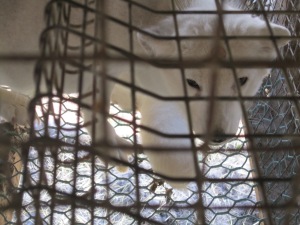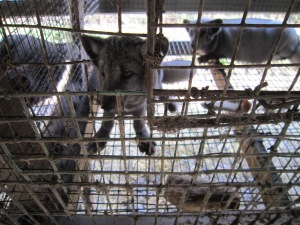Finland is the world’s biggest farmer of fur animals, and currently there are 965 farms in the country. Foxes, minks and raccoon dogs are farmed in Finland in appalling conditions. Animals are kept in small metal wire cages, and in a typical farm there are about 10.000 animals, and it is often a family business. Many enthusiastic people want to start fur farms of their own, because the country shows green light for farming. Most of fur sold in USA is from Finnish fur farms, and Burberry, among others, co-operates with Saga Furs. The annual income of fur industry in Finland varies from about 200 000 000 € to 500 000 000 €.
Fur farming has been banned by law in United Kingdom (2002), Austria (2004) and in Croatia (2007 with 10 year transition time). Netherlands will end fur farming by year 2024. In addition Belgium’s largest territory Wallon bans fur farming from 2015 on and Sao Paulo state in Brazil bans fur farming since January 2015. Fur farming has been restricted by law or its made practically economically unprofitable with strict laws for animal wellbeing in Netherlands, Italy, Sweden, Switzerland, Denmark and New Zealand. Finland’s laws concerning fur farming are thus in flagrant incongruence with the laws of most other European countries.

Fig. 1. A cross fox looking at the photographer when visiting a Saga Furs certified fur farm in Ypäjä, Finland in September 2014. Photographer: Anti-Fur Society, Finland.
In 2013 there was a historical national initiative in Finland, aiming to end fur farming, signed by about 70.000 Finnish people. It was declined by the Parliament of Finland with votes 146 (against the initiative) – 36 (in favor, blank vote, or absent). The most common reasons for disapproval for ending fur farming in the country is, that if Finland stopped farming fur animals, the industry would only move to other countries such as China, where conditions for farming are even worse. However, Finnish fur farmers have sold fur animals to China in the history (e.g. in the 80’s), and fur is heavily marketed especially to China and Russia. In other words Finland is highly involved with the establishment of fur farms and fur business in China. Fur farming has thus already begun in China, and it is not dependent on the Finnish fur industry to continue. However, the more farming and industry there is, the more machinery there is also for sales and marketing all over the world. So fur industry in any country feeds the markets in other countries!
Fig. 2. Two blue fox cubs in the fur farm in Ypäjä, Finland September 2014. Photographer Anti-Fur Society, Finland.
Saga Furs is the biggest retailer of Finnish fur, and they have a quality certification system which takes in consideration the safety and hygienity of farms, wellbeing of animals as well as bookkeeping system. In the certified farms, a specialized vet is called on place if animals suffer from sicknesses. Anti-Fur Society, Finland visited a Saga Furs qualified high standard fur farm in Ypäjä, Finland in September 2014. There were over 9000 animals, foxes (Figs. 1, 2 and 3) and minks (Fig. 4), in the farm, and just two people were taking care of the animals on a regular basis. The cage size was small as usual, and the animals were over-weight, often suffered from leg problems and some animals suffered from eye-infections that were being treated. Apart from the structural problems, the animals were clearly depressed (very passive and uninterested) and frustrated (uninterested or wanted to get out of the cage). Depression is indeed inevitable in such monotonic and bad living conditions. Some animals, though not many, displayed stereotypic behavior, and just kept going round in the cage. Most fur animals live only 7 months in the farms, after which foxes are anally electrocuted and minks are gassed to death by carbon dioxide gas. Foxes do not breed naturally in farms, so they are artificially fertilized. Fox is a shy animal in nature, and it is highly stressful for foxes to be kept so densely in the fur farms. Minks are playful and daily cover many kilometers in nature, just like foxes and raccoon dogs. Foxes have a natural desire for digging and minks for swimming, neither of which is possible in the metal wire cages either.

Fig. 3. A stressed blue fox in the cage in Ypäjä, Finland in September 2014.
Saga Furs is proud of its certificate system, and claims that fur animals are well taken care of in Finland, and that they are content. They further claim, that the animals in the farms are not the same as in nature, and that there is 100 years of artificial breeding of captive animals, which leads to farm animals being adapted into the artificial cage conditions. The calmest animals are selected for farming. Many structural disabilities have been brought live by crossing of the captive animals. Leg deformations are the most conspicuous structural problems, which are widespread among the animals.
The fur animals are handled as mass, and their individual needs are in no way taken into account. They are deprived and neglected of even their very basic biological needs. Yet those in favor of the industry stubbornly claim the animals are happy, and that happiness is not measured by fulfilling of natural needs of the animals. Recently many people are protesting against fur farming worldwide, and spreading awareness of the cruel and sad plight of these innocent animals, abused by man. We in Anti-Fur Society Finland, have one goal, and it is to make fur farms as well as blood sports and any killing of animals for their skin or fur illegal all over the world.

Fig. 4. A mink in the cage in the fur farm in Ypäjä, Finland in September 2014. The stuff on the cage is food, which contains e.g. soy for protein as well as herring from the Baltic Sea.
Please sign and share, by clicking on the link below, the petition to Finland’s Parliament, to demand an end to fur farming in Finland!
http://www.thepetitionsite.com/814/930/957/demand-an-end-to-fur-industry-in-finland-now/

Nothing is ethical when it involves killing animals for any reason.